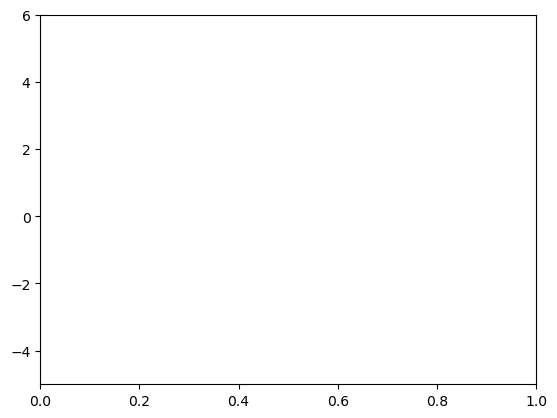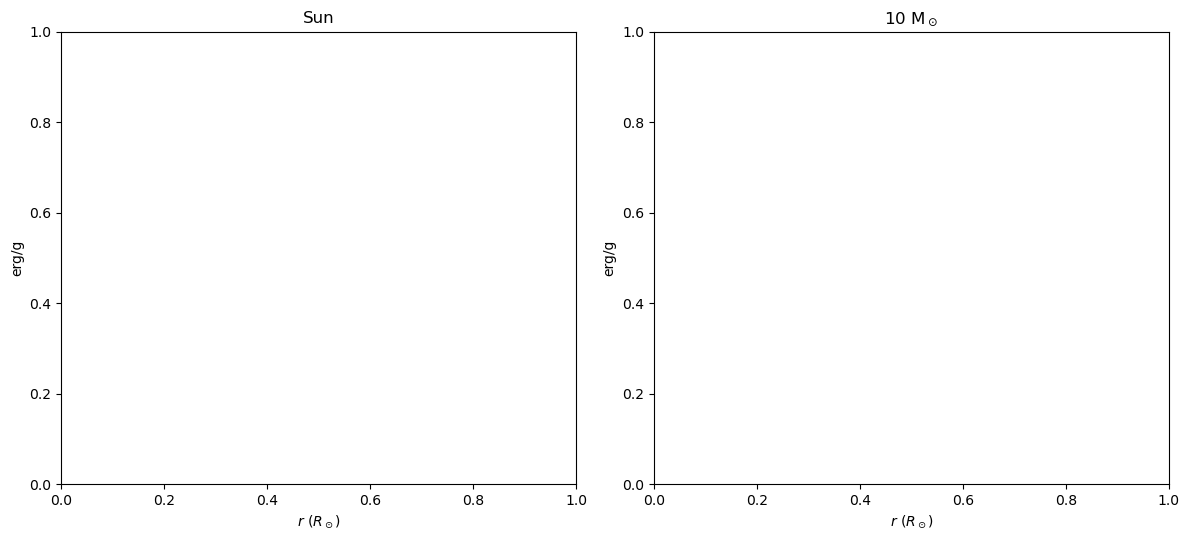22-NuclearEnergy (template)#
import numpy as np, copy
import matplotlib.pyplot as plt
%matplotlib inline
from astropy import constants as const
import astropy.units as u
from astropy.units import cds
cds.enable()
<astropy.units.core._UnitContext at 0x105f87370>
1. At home: pp vs CNO rates#
TODO
Make a plot of \(\log(\epsilon)\) as a function of \(\log(T)\) for the PP-I chain and the CNO cycle, based on the expression given in class (from Kip 18.5.1). Use the temperature range already given in the code below.
In both cases (PP-I and CNO), by how much does the \(\epsilon\) changes for a change of temperature of one order of magnitude?
If you were to reproduce \(\epsilon\) in the range of temperature below by a power law of the form \(\epsilon \propto T^\nu\), what would the index \(\nu\) of the power law be? (Graph a curve to find your answer.)
fig, ax = plt.subplots(1,1)
ax.set_ylim(-5,6)
logT = np.linspace(6,8,50)
#########################
# At home

TODO: Write a caption for your graph, and answer the questions asked.
2. Let’s look at the energy generation in our MESA models#
Reading in the models#
First, use the cell below to read in the two MESA models from the convection notebook for the Sun (in variable Msun) and for a 10 \(M_\odot\) star (in variable M10).
def read_model(file):
return np.genfromtxt(file, skip_header=5, names=True)
Msun = read_model('https://raw.githubusercontent.com/veropetit/PHYS633-F2024/main/Book/L19-Convection/19-Sun-profile8.data')
M10 = read_model('https://raw.githubusercontent.com/veropetit/PHYS633-F2024/main/Book/L19-Convection/19-M10-profile8.data')
1. In class: we will look at the energy generation in the Solar model.#
In MESA, the column named eps_nuc gives the total power per gram coming from all of the nuclear reactions. The columns pp and cno give the power/g coming from the PP (I, II, and III) chains and the CNO cycle, respectively.
We will make a gapph of \(\epsilon_\mathrm{nuc}\), \(\epsilon_\mathrm{pp}\) and \(\epsilon_\mathrm{cno}\) as a function of radius, and then compare the values in MESA with the values we get from the formula given in the textbook.
At home:#
TODO
On the left graph, add curves for the \(\epsilon_\mathrm{nuc}\), \(\epsilon_\mathrm{pp}\) and \(\epsilon_\mathrm{cno}\) given by the MESA model.
Make a similar plot for the 10 \(M_\odot\) model on the right graph.
In the interpretation box below, comment on the similarities/differences between the two models.
Use the analytical expression for \(\epsilon_\mathrm{pp-1}\) and \(\epsilon_\mathrm{cno}\) from Part 1 to calculate your expected values for \(\epsilon_\mathrm{pp-1}\) and \(\epsilon_\mathrm{cno}\) in both models, and add these curves to your plots. In the MESA model, you will some useful columns such as:
logRhofor the logarithm10 of the density in g/cm2
logTfor the logarithm10 of the temperature in K
h1for the mass fraction of hydrogen
c12,n14,o16,o18for the mass fraction of important isotopes of carbon, nitrogen, and oxygen.In the interpretation box below, compare your calculation in #4 to the real \(\epsilon\) in the models. If there are any differences, comment on what could explain these discrepencies.
fig, ax = plt.subplots(1,2, figsize=(12,5.5))
ax[0].set_title('Sun')
ax[1].set_title(r'10 M$_\odot$')
ax[0].set_xlabel('$r$ ($R_\odot$)')
ax[1].set_xlabel('$r$ ($R_\odot$)')
ax[0].set_ylabel('erg/g')
ax[1].set_ylabel('erg/g')
plt.tight_layout()
#########################
# In class
#########################
# At home

TODO Write a caption for your graph, and answer the questions asked.

